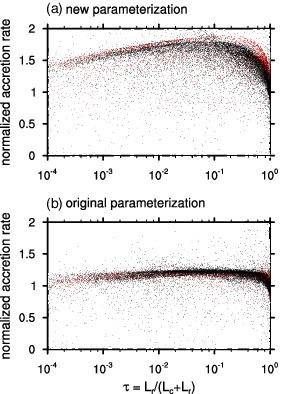当前位置:
X-MOL 学术
›
Q. J. R. Meteorol. Soc.
›
论文详情
Our official English website, www.x-mol.net, welcomes your
feedback! (Note: you will need to create a separate account there.)
A physically based raindrop–cloud droplet accretion parametrization for use in bulk microphysics schemes
Quarterly Journal of the Royal Meteorological Society ( IF 3.0 ) Pub Date : 2020-06-11 , DOI: 10.1002/qj.3850 Tanvir Ahmed 1, 2 , Han‐Gyul Jin 1 , Jong‐Jin Baik 1
Quarterly Journal of the Royal Meteorological Society ( IF 3.0 ) Pub Date : 2020-06-11 , DOI: 10.1002/qj.3850 Tanvir Ahmed 1, 2 , Han‐Gyul Jin 1 , Jong‐Jin Baik 1
Affiliation

|
The accretion process in bulk cloud microphysics schemes can be parametrized using the stochastic collection equation (SCE). In this study, the collection efficiency of each raindrop–cloud droplet pair is applied to the SCE to derive a new accretion parametrization that considers a strong variability of accretion rate depending on the cloud droplet and raindrop size distributions. To evaluate the new accretion parametrization (NP), it is implemented into a cloud‐resolving model, replacing the original accretion parametrization (OP) based on the continuous collection equation. In the idealized simulations of deep convective clouds, NP predicts overall larger accretion rates and smaller autoconversion rates than OP. The resultant high accretion/autoconversion rate ratio in NP increases the mean raindrop size. This induces faster sedimentation of raindrops that is associated with the earlier onset of surface precipitation and also weakens the evaporation cooling of raindrops that can affect the thermodynamics and dynamics of clouds. Meanwhile, for a given pair of rainwater and cloud water mass contents, the accretion rates in NP have a broad distribution while those in OP are less variant, suggesting that the dependence of the accretion rates on bulk microphysical properties other than the mass contents also needs to be properly considered in accretion parametrizations. Most of the aforementioned differences between the two accretion parametrizations found in the idealized simulations are also found in the real‐case simulations of a precipitation event over Bangladesh but the differences are smaller, and the spatial distribution of the accumulated precipitation amount is relatively well predicted by NP compared to OP.
中文翻译:

基于物理的雨滴-云滴增生参数化,用于批量微物理方案
可以使用随机收集方程(SCE)来参数化散云微物理学方案中的吸积过程。在本研究中,将每个雨滴-云滴对的收集效率应用于SCE,以得出新的吸积参数化,该参数考虑了取决于云滴和雨滴大小分布的吸积率的强变化性。为了评估新的吸积参数(NP),将其实施到云解析模型中,以基于连续收集方程的方式替换原始的吸积参数(OP)。在深对流云的理想模拟中,NP预测总体上比OP更大的吸积率和较小的自动转换率。NP中产生的高吸积/自转化率比率会增加平均雨滴大小。这会导致雨滴更快地沉降,这与表面降水的较早发生有关,并且还会削弱雨滴的蒸发冷却,从而影响云的热力学和动力学。同时,对于给定的一对雨水和云水质量含量,NP中的吸积率分布较宽,而OP中的吸积率变化较小,这表明除质量含量外,吸积率还依赖于体积微物理性质在吸积参数中适当考虑。在理想化模拟中发现的两个吸积参数之间的大多数上述差异,也可在孟加拉国上空降水事件的实际模拟中找到,但差异较小,
更新日期:2020-06-11
中文翻译:

基于物理的雨滴-云滴增生参数化,用于批量微物理方案
可以使用随机收集方程(SCE)来参数化散云微物理学方案中的吸积过程。在本研究中,将每个雨滴-云滴对的收集效率应用于SCE,以得出新的吸积参数化,该参数考虑了取决于云滴和雨滴大小分布的吸积率的强变化性。为了评估新的吸积参数(NP),将其实施到云解析模型中,以基于连续收集方程的方式替换原始的吸积参数(OP)。在深对流云的理想模拟中,NP预测总体上比OP更大的吸积率和较小的自动转换率。NP中产生的高吸积/自转化率比率会增加平均雨滴大小。这会导致雨滴更快地沉降,这与表面降水的较早发生有关,并且还会削弱雨滴的蒸发冷却,从而影响云的热力学和动力学。同时,对于给定的一对雨水和云水质量含量,NP中的吸积率分布较宽,而OP中的吸积率变化较小,这表明除质量含量外,吸积率还依赖于体积微物理性质在吸积参数中适当考虑。在理想化模拟中发现的两个吸积参数之间的大多数上述差异,也可在孟加拉国上空降水事件的实际模拟中找到,但差异较小,











































 京公网安备 11010802027423号
京公网安备 11010802027423号